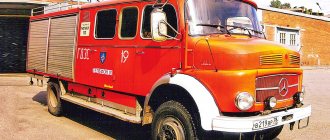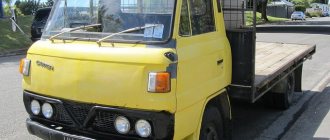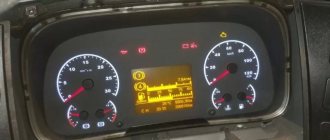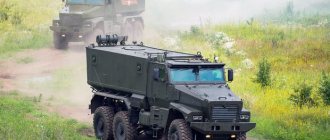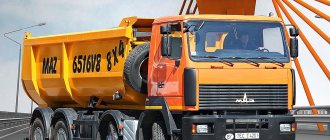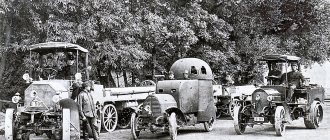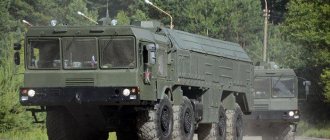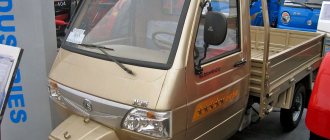By 1915, the US Army was using trucks tactically, and for World War I it began purchasing them in large quantities. Early trucks were often designed for both military and commercial use, with military models later being built. Since 1940, the US military has ordered more than 3,000,000 tactical trucks. The US Marines used both the US Army and their own models, some of which are shown.
The ton rating (907 kg) is the payload of the base cargo version of the truck, not the standalone version.
The designation "wheel formula" is the number of wheels multiplied by the number of drive wheels. Each axle has two wheels; dual tires count as one wheel. Some series have models with both one and two tires.
"Total built" typically includes costs for US troops and any export orders.
Notes
- Also built by Hudson, National and Paige-Detroit.
- Also built by Mitchell, Kissel and Primer.
- Modified with a live front axle from Marmon-Herrington.
- Also built as Ford GPW
- ^ a b
Also built by Chevrolet - Also built by REO.
- Also built by Corbitt (designer), FWD, Ward LaFrance and White.
- Includes everything built by 10 manufacturers.
- Includes International Harvester, Diamond T, Kaiser Jeep and Mack built.
- Includes Ford and Willys/Kaiser Jeep/AM General.
- Prototypes have been tested in Germany and Vietnam since 1962.
- Does not include prototypes.
- Up to 20 tons.
- Also 6x6 and 8x6
- Commercial Heavy Equipment Transporter
- Commercial truck
- High mobility multi-purpose wheeled vehicle
- Includes AM General and Bowen-McLaughlin-York buildings.
- Heavy tactical truck with increased mobility
- Light Medium Tactical Vehicle
- Medium tactical vehicle
- Also 18 1⁄2 and 20 ton
- Also 6x6
- Heavy Equipment Transporter
- Navistar F7400 SFA 6x6
- Replacement of medium tactical equipment
- Replacement of the logistics transport system
Post-war American army trucks
As you know, the fleet of the American Army and Marine Corps during World War II was very far from uniform
In service with the American army, only 2.5-ton three-axles (hereinafter, the load capacity on the ground) had three main options, poorly unified among themselves (and this is not counting the half-hood versions). With the rest of the equipment, with a lifting capacity of 5 and 10 tons, the situation was a little better, but still far from ideal. It was time to announce a new competition and bring order to this chaos.
Good morning, Vietnam! Another gasoline M35 in a typical southern design with the canvas top and windshield removed
The winners of the competition in 1949 were REO (2.5 tons), International (5 tons) and Mack (10 tons). However, I’ll tell you about Mack and his heirs another time. For now, we note that for complete unification, all three families received almost identical cabins with an easily dismantled hard top, which could be easily replaced with an awning. And the wings, hood and radiator grilles looked, if not identical, then very similar. All this, according to the wise plan of the command, was supposed to simplify repairs in the field and, in addition, greatly complicate the life of enemy reconnaissance. After all, it was possible to clearly distinguish the new American five-ton from the ten-ton only by placing them side by side! What if an enemy spy is watching the column from afar, and even in the dark, twilight, rain or fog? Go guess what kind of equipment is moving!
Looking ahead a little, I note that loyalty to the original idea of the same design was maintained only until the 1970s. Then began various metamorphoses, throwing around, searching for the best manufacturer for the entire range of army trucks and, in the end, switching to completely different vehicles. But first things first.
In a red uniform. Airfield fire truck 530V on M34A1 chassis
FAMILY OF BEAVERS
The 2.5-ton machine developed by REO went into production in 1951. The main models were standardized as M34 (with single tire rear axles) and M35 (with dual wheels). Studebaker, the loser of the competition, received a nice consolation prize - a share of the order for the production of the REO design. In general, the history of World War II, when REO produced the Studebaker US6, repeated itself exactly the opposite.
From a design point of view, the car turned out to be much more advanced than what both companies did during the war. The engine was a petrol overhead valve six-cylinder Continental or REO (5.4 l, 127 hp), the gearbox was a five-speed synchronized gearbox, the transfer case was a two-speed with an automatically engaged front axle. Brakes – hydraulic with booster. The maximum speed was 90 km/h.
Herald of the Apocalypse. Two five-ton trucks in the process of reloading a Honest John nuclear missile. On the right is the M289 launcher with an open cockpit, on the left is the M62 loading machine
The truck featured sealed electrical equipment and the ability to install snorkels, which earned it the nickname “beaver.” And after it proved itself to be an exceptionally reliable and durable car, it began to be called the eager beaver, an idiom that means “hard worker” or even “workaholic.”
In 1962, the gasoline engine was replaced by a multi-fuel diesel engine with the ability to run on gasoline and oil, developed by Continental together with MAN. In the turbocharged version, it developed a power of 134 hp. With. (113 hp on gasoline) with a working volume of 7.8 liters. This is how the M35/M34A1 modification appeared, which was externally distinguished mainly by the high exhaust pipe on the right side.
By 1971, the production facilities for the production of 2.5-tons, both the former Studebaker (bought out by Kaiser in the 60s) and the former REO (for some time became part of White), became the property of the American Motors Corporation. Again, looking ahead a little, I note that they also began production of the five-ton family. For convenience, a special department for the production of military equipment was founded - the well-known AM General.
Round front. The latest modification of the M34A3 featured a distinctive radiator grille design and central tire inflation
Subsequently, American Motors specialists were busy slowly polishing the successful car, simultaneously launching into series new modifications like the two-axle M600, designed specifically for Europe. A seriously revised version of the M34/M35A3 appeared only in 1993. It featured a new radiator grille design, central tire inflation, power steering, 4-speed automatic transmission, new axles and transfer case, as well as a Cummins diesel engine (6.6 liters, 170 hp). It was produced until 1999. In addition, the M34/M35 was produced under license by the Canadian company Bombardier (model MLVW) and the Korean KIA.
AUTOMATIC ALTERNATIVE
In 1950, a serious war broke out on the Korean Peninsula. Relations were being sorted out on the one hand by the People's Republic of Korea and also the Democratic Republic, led by Comrade Kim Il Sung, on the other by simply the Republic of Korea, where the protege of American imperialism, Syngman Rhee, ruled. But this very imperialism was only partly ready for a serious fight. The gigantic fleet of vehicles built during World War II was reduced to peacetime size, and the surplus was either distributed to the allies as a thank you, or sold to anyone who wanted it at almost the price of scrap metal.
Find 10 differences. Canadian copy of M34 - Bombardier MLVW externally difficult to distinguish from the original
Meanwhile, the war was heating up, and more and more equipment was needed. It got to the point that we even had to involve the Japanese, which was logical - the transport was very close. At this critical moment, the military remembered the General Motors creation that had lost the competition with the same carrying capacity - 2.5 tons. One of the reasons why this creation was rejected was the GM Hydra-matic four-speed automatic transmission, which was too unusual for that time. Otherwise, the all-wheel drive GMC Army was similar to the REO M35, except that the transfer case was single-speed.
Naturally, they used their own engine: an in-line six-cylinder petrol with a displacement of 4.9 liters and a power of 130 hp. With. Speed – 90 km/h. The main modifications were standardized as M135 (with a single-pitch rear axle tire) and M211 (with a dual-pitch one). The “automatic alternative” was produced for only five years, from 1952 to 1957, and then it began to slowly go to the same allies and be transferred to the National Guard, which, as you know, always “wears” outdated weapons for the American army.
The fate of the car is historically accurately depicted (by Hollywood standards, of course) in the cult films “Sorcerer” (1977) and “Rambo. First Blood" (1982). In the first, two M211 trucks are “finished off” by an oil company somewhere in the jungles of South America. The plot revolves around the fate of four scoundrels who decided to make money by transporting nitroglycerin, for which the GMC with its smooth automatic transmission was just perfect. In the second film, the M135 transports cargo for the National Guard, which is hunting the main character, John Rimbaud.
A movie character with a machine gun. Directors love the GMC M211 for its expressive appearance and ease of operation.
HONEST JOHN
The five-ton family entered production somewhat late - only in 1954. Production was almost evenly distributed among three companies: International itself, Diamond and Mack. The main modifications, as in the case of the 2.5-ton models, were distinguished by dual wheels on the rear axles (M54) or single wheels (M39). The engine at first was also a gasoline Continental with a solid displacement of 10 liters and a power of 196–224 hp. With. The design of the chassis and transmission was the same as the 2.5-ton family. Even the brakes were hydraulic with a vacuum booster. Option A1 received a Mack turbodiesel (11 l, 210 hp), option A2 received a multi-fuel Continental (7.8 l, 205 hp). The speed was 85 km/h.
In Soviet literature, there was increased interest in five-ton tanks, because the long-wheelbase modification of the M139C was equipped with Honest John short-range missile launchers, mostly with nuclear warheads. In Vietnam, five-ton trucks were often converted into “guntrucks” to protect columns from partisans. These were partially or fully armored vehicles, armed with machine guns and in some cases 20 mm automatic cannons.
Mad Max is resting. The maximum guntruck The Colonel (“Colonel”) from the Vietnam War, created by merging a faulty M113 armored personnel carrier and a five-ton M54
In 1971, production of five-ton cars was transferred to AM General. The family was immediately updated and standardized as the M809. On this occasion, power steering finally appeared, and the diesel engine was replaced with Cummins (14 liters, 240 hp). Externally, the car was distinguished by a slightly rounded front end.
In 1982, the honored veteran was again seriously modernized. Now the hood, fenders and radiator grille were combined into a block that could be easily folded forward for better access to the engine. The new-old M939 (with single-pitch tires) received a five-speed automatic transmission, air brakes, a central tire inflation system and... a fashionable, angular, heavy design of the radiator grille. Over time, a new Cummins diesel appeared with the same power as the old one, but with a volume of 8.3 liters. In addition, the same machines were produced in parallel by BMY for some time.
New design. The five-ton boat transporter M821 from AM General (1971) was distinguished by a characteristic radiator grille
The trucks turned out to be fast - 101 km/h, but at the same time extremely dangerous to drive. It got to the point that a third of all fatal accidents involved the redesigned AM General five-ton truck. The tragedy was that when braking hard with the brakes locked, the torque converter would often lock up in second gear. Naturally, the engine immediately stalled and, accordingly, the power steering was turned off. At the same time, the steering “bite”. The problem was partially solved by installing a speed limiter to 65 km/h. And in 1999, all “harmful” trucks received ABS. However, by that time their reputation was damaged, and the design had become outdated after 50 years.
As a result, the veteran was sent into retirement, and International and Oshkosh became the main suppliers of the army and navy. It is interesting that the latter is currently, among other things, also engaged in major repairs, modernization and modification of all AM General trucks. For example, the company’s specialists equip restored cars with an anti-lock brake system (where it was not installed previously). It seems that the venerable family will serve for a long time.
Minus one bridge. The two-axle version M34 - M600 was produced specifically for Europe
Easy to maintain. The last update to the five-ton M939 family (1982) boasted excellent engine access
Recommendations
- ^ a b
Creason, Fred W. (2001).
US Military Wheeled Vehicles
(3rd ed.). Pub Victory of the Second World War. ISBN 0-970056-71-0. - Artillery Data Handbook
(PDF). United States War Department, 1919. Retrieved March 18, 2022. - TM 9-803 ¼-ton 4x4 truck (Willys-Overland Model MB and Ford Model GPW)
(PDF). US Department of the Army. 1944. Retrieved June 25, 2022. - TM 9-8083⁄4-ton 4×4 truck (Dodge)
(PDF). US Department of the Army. 1944. Retrieved June 25, 2022. - TM 9-8051 1⁄2 Ton 4×4 Truck (Chevrolet)
(PDF). United States War Department, 1943. Retrieved June 25, 2022. - TM 9-8012 1⁄2-ton 6 × 6 GMC CCKW
(PDF). United States War Department, 1944. Retrieved June 25, 2022. - TM 9-8022 1⁄2 Amphibious truck, 6×6, GMC DUKW-353
(PDF). U.S. War Department, 1943. Retrieved June 25, 2019. - TM 9-8072 1⁄2-ton 6×6 Truck and 2 1⁄2 to 5-ton 6×4 truck
(PDF). U.S. War Department, 1943. Retrieved June 25, 2019. - TM 9-811 4-Ton 6x6 Trucks (Diamond T Models 968A (and others))
(PDF). United States War Department, 1944. Retrieved June 25, 2022. - 6-ton truck 6x6 TM 9-813 (White, Corbit, Brockway)
(PDF). United States War Department, 1944. Retrieved June 25, 2022. - TM 9-796 M1A1 Heavy Salvage Truck (Kenworth Model 573, Ward LaFrance Series 5)
(PDF). US Department of the Army. 1953. Retrieved June 25, 2022. - TM 9-768 45-ton tank Car transporter M19
(PDF). US Department of the Army. 1944. Retrieved June 25, 2022. - TM 9-767 Tank trailer 40 tons M25
(PDF). United States War Department, 1942. Retrieved June 25, 2022. - Dishes (2014)P. 66-67.
- TM 9-804A ¼-ton universal truck 4×4 M38A1
(PDF). US Department of the Army. 1952. Retrieved June 25, 2022. - TM 9-2320-213-10 Operating manual for truck, platform: 1⁄2-ton 4x4 M274 (and others)
(PDF). US Department of the Army. 1963. Retrieved June 20, 2022. - TM 9-2320-212-10 Operator's manual Truck, cargo, 3⁄4-ton 4x4 M37 (Series)
(PDF). US Department of the Army. 1973. Retrieved August 30, 2015. - TM 9-2320-209-10-1 Operation, Installation and Reference Data Operator Level 2 ½-Ton, 6x6, M44A1 and M44A2 Series (Multi-Fuel) Trucks
(PDF). - TM 9-2320-211-10 6X6 Series 5-Ton Truck Operator's Manual, M39
(PDF). US Department of the Army. 1977. Retrieved June 20, 2022. - TM 9-2320-206-10 Operator's Manual Truck, Tractor: 10 Ton, 6X6, M123 (etc.)
(PDF). US Department of the Army. 1977. Retrieved June 20, 2022. - TM 9-2320-218-10 Truck Operator's Manual, General Duty: 1/4 Ton, 4x4, M151 (etc.)
(PDF). US Department of the Army. 1968 - TM 9-2320-266-34 Direct and General Maintenance Manual Truck, cargo:1 1⁄4-ton 4x4 M880 (and others)
(PDF). US Department of the Army. 1976. Retrieved June 16, 2022. - TM 9-2320-260-10 Operator's manual Forklift 5 tons, 6×6, M809 series
(PDF). US Department of the Army. 2003. Retrieved June 16, 2022. - TM 9-2320-283-10 Truck, Tractor, Linear Traction Manual: 50,000 GVWR, 6x4, M915A1 (etc.)
(PDF). US Department of the Army. 2006. Retrieved June 20, 2022. - TM 9-2320-289-10 Operator's Manual for Trucks, Trucks, Tactical,1 1⁄4-Ton, 4x4, M1008 (and Others)
(PDF). US Department of the Army. 1992. Retrieved June 20, 2022. - TM 9-2320-280-10 Truck Owner's Manual, Utility: Truck/Military,1 1⁄4-ton, 4x4, M998 (and others)
(PDF). US Department of the Army. 2004. Retrieved June 20, 2022. - TM 9-2320-272-10 Truck Operator's Manual, 5 Ton, 6x6, M939 (etc.)
(PDF). US Department of the Army. 2004. Retrieved June 20, 2022. - TM 9-2320-279-10-1 Operator's Manual M977 8x8 Series Heavy Mobility Tactical Trucks (HEMTT)
(PDF). US Department of the Army. 1998. Retrieved June 20, 2022. - TM 9-2320-365-10 M1078 Series 2 ½ Ton 4x4 Light Medium Tactical Vehicle (LMTV) Operator's Manual
(PDF). US Department of the Army. 2005. Retrieved June 20, 2022. - TM 9-2320-36-10 Operator's Manual M1083 Series 5-ton, 6x6 Medium Tactical Vehicles (LMTV)
(PDF). US Department of the Army. 2005. Retrieved June 20, 2022. - TM 9-2320-302-10 Truck, Tractor, Linear Vehicle Operators Manual: 52000 GVWR, 6x4, M915A3 (and others)
(PDF). US Department of the Army. 2010. Retrieved June 20, 2022.
- Creason, Fred W. (2001). US Military Wheeled Vehicles
(3rd ed.). Pub Victory of the Second World War. ISBN 0-970056-71-0. - Doyle, David (2003). Standard Catalog of United States Military Equipment
. Krause Publications. ISBN 0-87349-508-X. - Vanderveen, Bart (1998). List of military Macks on and off duty
. After the battle. ISBN 1-870067-09-6. - Ware, Pat (2014). An Illustrated Guide to Military Equipment
. House of Hermes. ISBN 978-1-78214-192-1. - Artillery Data Handbook
(PDF). US War Department, 1919, pp. 362–379. Retrieved March 18, 2022. - Military Equipment Forecast: US Tactical Equipment
. Forecast International. 2003. Retrieved March 9, 2022. - Standard passports of military equipment
. Ordnance Tank Automotive Cmd. 1959. Retrieved December 14, 2016. - TM 9-500 Ammunition Specifications
(PDF). US Department of the Army. 1962. Retrieved April 23, 2018. - Standard Military Vehicles TM 9-2800
(PDF). U.S. War Department, 1943. Retrieved March 18, 2020. - TM 9-2800 Military equipment
(PDF). US Department of the Army. 1947. Retrieved March 18, 2022. - TM 9-2800 Military equipment
(PDF). US Department of the Army. 1953. Retrieved March 18, 2022.
IVECO M250 (Italy)
The Italian company IVECO has a long tradition of producing specialized military trucks. IVECO M250 is a new series of tactical trucks that are designed to work on all types of roads and off-roads. The M250 military truck has a 6x6 wheel arrangement, and deliveries to the Italian Army began in 2003. These trucks were also supplied to the armies of Belgium, Spain and some other countries. Spanish trucks are designated IVECO-Pegaso.
Payload varies by version. The M250.45WM has a payload of 8,000 kg. It can also tow trailers and artillery pieces. Basic version - cargo/military transport. There are specialized versions available, such as the artillery tractor, dump truck and Centauro fire engine. The truck can be equipped with an optional armor kit that has built-in replaceable panels. The armor provides protection from small arms fire and shrapnel.
Tow trucks
The need for a huge amount of repair work led to the creation of special tow trucks. Their design made it possible to transport heavy army vehicles. They were distinguished by decent power and carrying capacity. For example, the Federal-606 repair and recovery vehicle was equipped with a 180 horsepower engine and a crane capable of lifting a ten-ton load.
Trucks can be used for more than just transporting goods. For example, a rare American Kenworth W100 tractor was converted into a camper with a luxurious interior .
